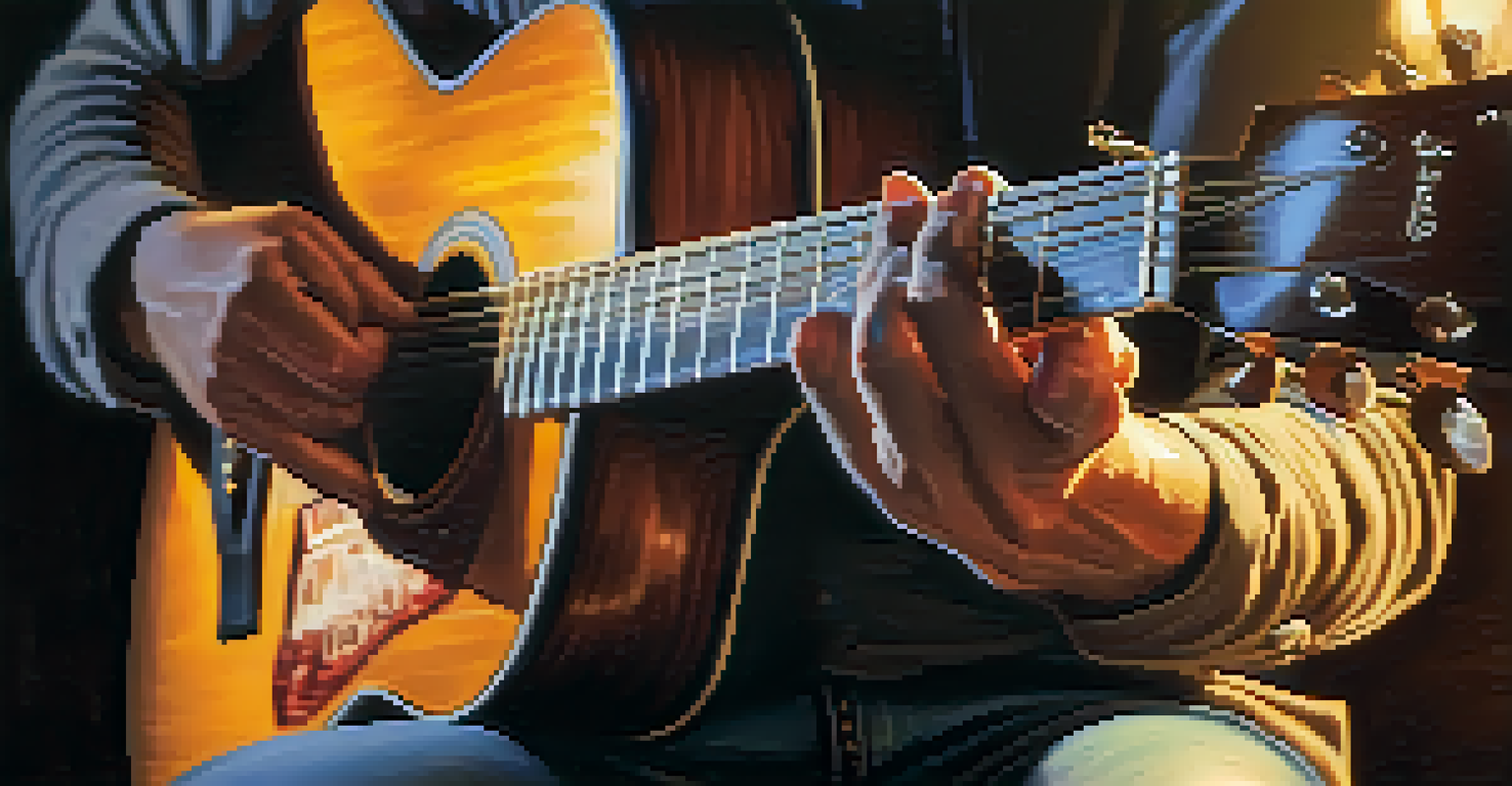Creating Emotional Impact Through Song Structure on Guitar

Understanding the Basics of Song Structure
Every great song has a structure that guides listeners through its emotional landscape. Typically, a song will consist of sections like verses, choruses, and bridges, each serving a unique purpose. For example, verses often tell a story or set up emotional scenes, while choruses usually convey the main message or hook. Understanding these elements is crucial for any guitarist looking to create a lasting emotional impact.
Music is the shorthand of emotion.
Think of song structure like a map that leads your audience on a journey. Each section acts like a landmark, helping listeners navigate through the highs and lows of your composition. This way, they not only follow along but also feel the emotional weight of each musical turn. As you become more familiar with these components, you’ll gain the tools to craft a more compelling narrative in your music.
Moreover, recognizing how different genres utilize structure can inspire your own songwriting. For instance, pop songs often follow a simple verse-chorus format, while progressive rock may experiment with more complex arrangements. By understanding these conventions, you can better harness the emotional power of your guitar and connect with your audience.
The Role of Melody in Emotional Storytelling
Melody is the heart of a song, often conveying emotions that words alone cannot express. A well-crafted melody can evoke joy, sadness, or nostalgia, guiding the listener through the emotional journey you wish to share. For example, consider how a rising melody can create feelings of hope, while a descending line might elicit a sense of loss. This interplay between melody and emotion is vital for making a strong impact.

When constructing melodies on the guitar, think about how different notes and rhythms affect the overall feel of your song. For instance, using minor scales can create a darker, more introspective mood, while major scales often evoke brightness and cheerfulness. By experimenting with these different musical elements, you can enhance the emotional depth of your compositions.
Song Structure Guides Emotional Journey
Understanding song structure, including verses, choruses, and bridges, helps create a compelling narrative that resonates with listeners.
Additionally, don't underestimate the power of repetition in melody. Repeating a catchy hook not only makes your song memorable, but it can also reinforce the emotional themes you’re exploring. This technique draws listeners in, allowing them to feel the nuances of your music more deeply, making your emotional message resonate long after the song ends.
Using Chord Progressions to Set the Mood
Chord progressions play a pivotal role in establishing the emotional tone of a guitar piece. Different chords evoke different feelings; for example, a progression using minor chords can create a melancholic atmosphere, while major chords often sound uplifting and joyful. By thoughtfully selecting your chords, you can enhance the emotional impact of your song in subtle yet powerful ways.
The only truth is music.
Consider how famous songs utilize specific chord progressions to amplify their emotional messages. A classic example is the I-V-vi-IV progression, which appears in countless hits across genres. This particular sequence can evoke feelings of nostalgia and longing, making it a go-to choice for many songwriters. By understanding these common progressions, you can better express your intended emotions through your guitar.
Moreover, don’t shy away from experimenting with unconventional progressions. Sometimes, a surprising chord change can evoke a powerful emotional response from your audience. By breaking away from the expected, you can create moments of tension and release that heighten the overall emotional experience of your music.
The Impact of Dynamics and Rhythm in Your Playing
Dynamics and rhythm are essential tools for adding emotional depth to your guitar playing. Varying the volume and intensity throughout your song can create contrast, making climactic moments feel even more powerful. For instance, playing softly during a verse and then building up to a loud, energetic chorus can effectively capture your audience's attention and evoke strong feelings.
Rhythm, too, plays a crucial role in conveying emotions. A slow, steady rhythm might evoke a sense of calm or reflection, while a fast, driving beat can generate excitement and urgency. Think about how the timing of each note contributes to the overall emotional vibe of your piece. This attention to rhythm can make your music not only more engaging but also deeply moving.
Melody Shapes Emotional Expression
A well-crafted melody can convey complex emotions, enhancing the listener's connection to the song.
Additionally, consider how incorporating pauses or rests can enhance the emotional impact of your playing. Silence can be just as powerful as sound, giving listeners a moment to absorb and reflect on the emotions you're conveying. By mastering dynamics and rhythm, you can elevate your guitar compositions into truly emotive experiences.
Crafting Lyrics That Resonate with Emotion
While instrumental guitar pieces can be profoundly emotional, lyrics often provide an additional layer of connection. Well-crafted lyrics can tell a story or express feelings that resonate deeply with listeners. For instance, writing about personal experiences or universal themes, like love or loss, allows your audience to relate and engage more fully with your song.
When writing lyrics, think about imagery and metaphor. Vivid descriptions can transport listeners into the emotional landscape you’re creating. For example, instead of saying, 'I feel sad,' you might describe a rainy day that mirrors your emotions. This technique draws listeners in, allowing them to feel what you feel more viscerally.
Additionally, consider the rhythm and flow of your lyrics as they relate to your melody. A catchy, memorable chorus can amplify the emotional impact of your song. By aligning your lyrical content with the emotional tone of your guitar playing, you can create a powerful synergy that resonates with your audience long after the music fades.
The Power of Arrangement in Evoking Emotion
Song arrangement is about more than just the order of sections; it’s about crafting an emotional journey. The way you layer instruments, build tension, and resolve conflicts can significantly influence how listeners feel throughout the song. For instance, starting with a solo guitar and gradually adding layers can create a sense of anticipation that culminates in an emotional climax.
When arranging your song, consider how each instrument contributes to the overall emotional effect. A simple guitar melody can be transformed into a rich tapestry of sound by adding strings, percussion, or harmonies. This layering can enhance the emotional depth, making the music feel fuller and more immersive.
Performance Enhances Emotional Impact
Authentic performance, characterized by dynamics and engagement, can significantly amplify the emotional resonance of your music.
Moreover, think about transitions between sections. Smooth transitions can maintain the emotional flow, while abrupt changes might create tension or surprise. Both techniques have their place, but understanding how they affect the emotional arc of your song can help you create a more compelling listening experience.
Performing with Emotion: Connecting with Your Audience
The way you perform a song can significantly amplify its emotional impact. Engaging with your audience through your playing style, facial expressions, and body language creates a more intimate experience. For example, showing vulnerability during a heartfelt ballad can resonate deeply with listeners, making them feel more connected to your music.
Consider how dynamics and articulation in your playing can convey emotion. A gentle strumming pattern might evoke a sense of tenderness, while aggressive picking can express anger or passion. By being mindful of how you present your music, you can draw your audience in and invite them to experience the emotions you’re expressing.

Ultimately, performance is about authenticity. Sharing your genuine emotions while playing allows your audience to feel what you feel, creating a powerful connection. By embracing this vulnerability, you not only enhance your own experience but also ensure that your music leaves a lasting emotional impact on those who listen.